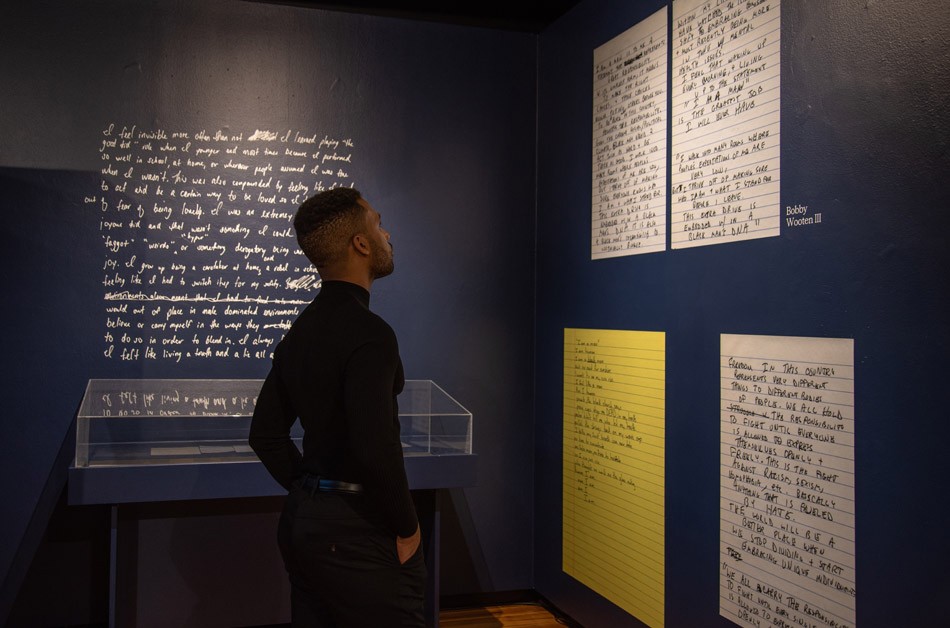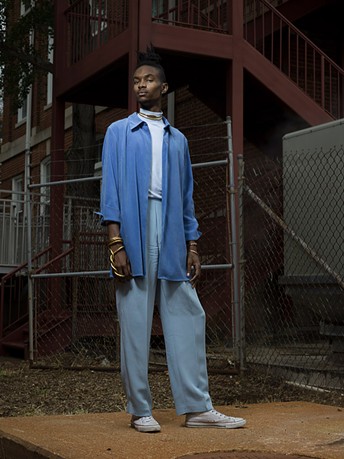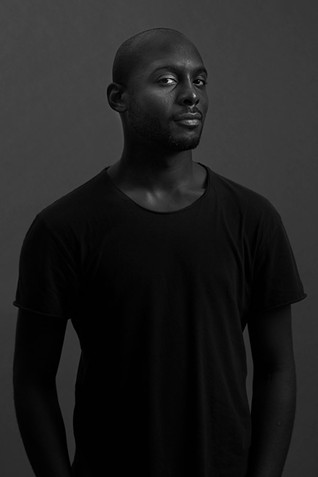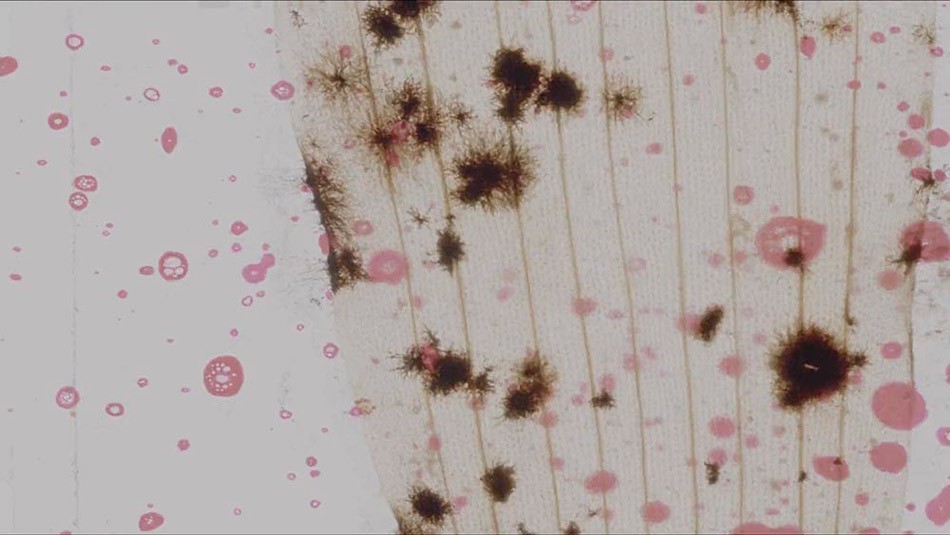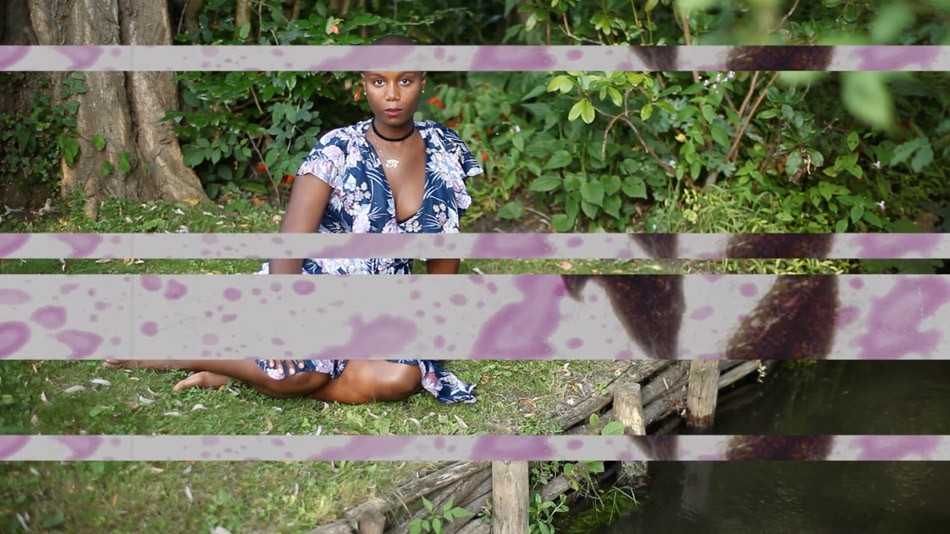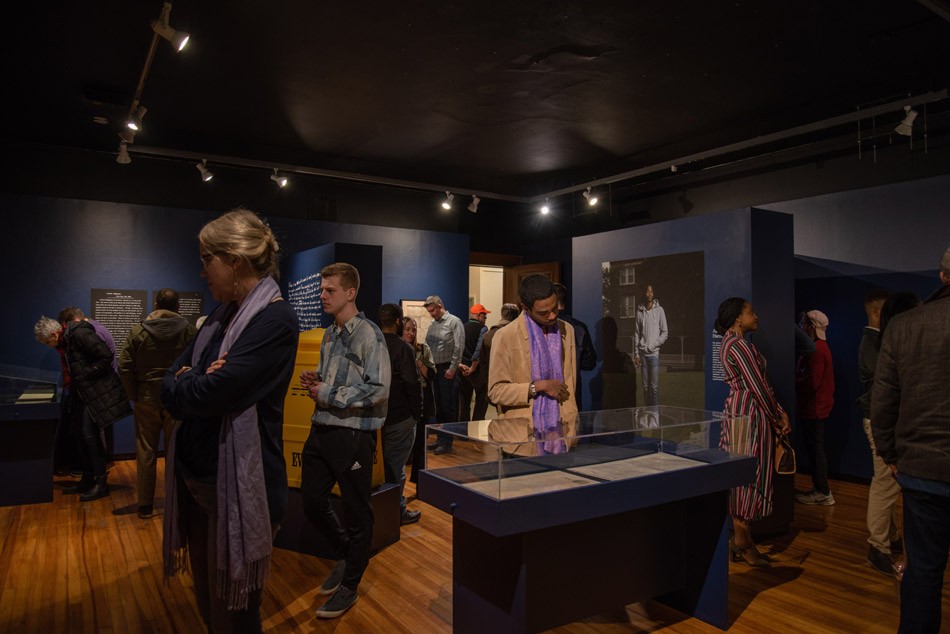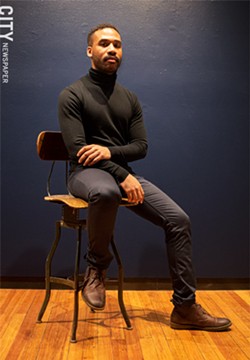Selfhood and safety in black America
Two artists explore black bodies and voices in modern America
By Rebecca Rafferty @rsrafferty[
{
"name": "500x250 Ad",
"insertPoint": "5",
"component": "15667920",
"parentWrapperClass": "",
"requiredCountToDisplay": "1"
}
]
The cops pull over a young black man who recently bought his first car. He's given no reason and watches helplessly as a police dog tears apart his new ride. When the cops and their canine turn up nothing, the man is dismissed with an ominous whisper from an officer: "You're lucky."
That's what the artist and Rochester native Joshua Rashaad McFadden says happened to him as a college student in North Carolina. He recalls how it sparked the conversation with his folks that so many black parents have with their children about how to conduct themselves when confronted by police. Dad instructs him to stand up for himself. Mom advises he be deferential.
"But we all know that there is no specific way to conduct yourself," McFadden says. "Because if you look at Philando Castile or you look at Sandra Bland — we can go on all day when there's different scenarios — and people do different things to try to de-escalate, but they end up dead."
He spoke from Visual Studies Workshop (VSW) on Prince Street, where he was installing his latest exhibition, "Evidence," an intimate look at the concepts of black masculinity and freedom as they relate to self-expression and representation. The work is on view through June 27.
Frederick Douglass once wrote of black people, "It is evident that we must be our own representatives and advocates." His words reverberate through McFadden's installation and a separate, but complementary, exhibition showing a block away in the Neighborhood of the Arts.
At the Memorial Art Gallery is a newly-acquired film installation by rising art-world star Ja'Tovia Gary, titled "Giverny I: Négresse Impériale." The work, which runs through April 5, interrogates the same concepts of selfhood and safety, the inner lives and outer realities, experienced by black people in America, but from a feminine perspective.
Specifically, her piece incorporates footage of Diamond Reynolds reacting to the 2016 police shooting of her boyfriend, Philando Castile, minutes after it happened; footage of speeches given by slain Black Panther Party member Fred Hampton, and footage of Gary herself finding her footing in the Eden-esque sprawl of Monet's gardens at Giverny.
Together, both artists explore the subjugating perceptions of black men in particular, the ways that black humanity has been suppressed and under-represented throughout the history of the United States, and the persistent violence and inequity that results from these perceptions and suppressions.
EXCLUSION AND SUPPRESSION
McFadden's show is a response to this exclusion and suppression — from imperialism to modern media's projections of black men — and the harm that it causes, from physically endangering black people to psychologically limiting self-expression.
"Evidence" is not just a photography exhibit. It is also a collection of the stories and reflections of its subjects. Functioning as an archive of real people contending with contemporary political and social issues, the piece includes a handful of large-scale portraits of young black men and their handwritten responses to questions of identity, masculinity, race, and sexuality. Also displayed are original editions of The North Star, the abolitionist newspaper founded by Douglass and on loan from the Central Library of Rochester and Monroe County. Capping the installation is a newspaper that McFadden produced and will distribute around town.
Originally from Rochester, McFadden studied at Elizabeth City State University in North Carolina and Savannah College of Art and Design in Georgia. He stayed in Georgia after earning his degree, teaching and developing his ideas and work. He's been back in Rochester since August 2019, and is now an assistant professor of photography at Rochester Institute of Technology.
McFadden's work is often connected to places of pivotal political and social history for black Americans. Places like Selma, Birmingham, Montgomery, and Charleston, where the Emmanuel church shooting happened in 2015. "Evidence" is the newest iteration of a project McFadden has been working on for about six years.
"It wasn't until maybe 2014 that I started to think about making portraits to talk about social issues," McFadden says. "Specifically, police brutality or negative perceptions of black males in America, ideas of masculinity or toxic masculinity, and using portraits to display humanity in the black person."
McFadden was living in Atlanta then. That was the year Michael Brown was fatally shot in Ferguson, Missouri, and demonstrations erupted around the country. It was also the 50th anniversary of the march from Selma to Montgomery. McFadden says he got emotionally caught up in the disturbing repetition of young black men being killed by police and the ensuing protests, some of which he took part in as both a marcher and a photographer.
"After that, I started thinking more about perceptions of black men: why are black men perceived as threats or as thugs, and so forth," McFadden says. "So I said, 'I need to do a project about perceptions of black men.'
But he didn't want to photograph in the streets like he did for his "After Selma" photo series. "I wanted to make it simple," McFadden says. "Kind of get rid of the chaos and also give power to these participants — in the power of their handwriting — to allow them to express their thoughts and speak directly to the viewer."
That work became 'Come to Selfhood,' a book of portraits published in 2016 that paired images of his subjects with a picture of their father or father-figure at that same age, along with responses to a survey of questions about male role models and definitions of masculinity.
UTTER HELPLESSNESS
The feeling of utter helplessness that McFadden felt during his encounter with the police on that North Carolina road all those years ago is compounded by Ja'Tovia Gary's film installation, "Giverny I" at the Memorial Art Gallery.
The short work artfully juxtaposes cell phone footage of the intensely emotional moments after Philando Castile was shot dead by a cop along a Minnesota highway, with footage of Gary amid flowers and ponds in the relative peace of Giverny.
Notably, Gary's film avoids images of Castile dying and focuses on the horrified reactions of his girlfriend, Diamond Reynolds. Though overcome with shock and grief, she remains in control of herself while the officer points his gun into the car and her young daughter sits in the backseat.
Gary's actions in the bucolic Giverny parallel Reynolds's experiences on the highway. When the officer barks "Back up!" Gary rapidly retreats into foliage as if she has no right to peacefully stroll in the sun or recline in the garden. While Reynolds contains her horror the best she can, in Giverny, Gary doubles over and screams her heart out on Reynolds's behalf.
Like the evolution of McFadden's photo projects, Gary's film is part of an ongoing "Giverny" series of installations, each taking a look at black experiences through a new prism. In this iteration, she includes bits of Fred Hampton speaking about revolutionary education, alluding to how his empowerment of the black community led to his killing by the FBI in 1969 at age 21, while he slept in bed with his girlfriend who was 9-months pregnant.
CLARIFYING CHAOS
Between "Come to Selfhood" and "Evidence," McFadden's archive project has evolved from ideas about black masculinity as a broad statement to include nuances of how people think about gender and identify within newer understandings of it.
"With 'Evidence,' I didn't ask pointed questions that you see in 'Come to Selfhood,'" McFadden says. "I more so gave the participants two prompts: 'Freedom' and 'I Am A Man' and they're just responding to what they think about those things."
The collaboration with his subjects is successful. Photographed in various green and concrete environments or against a gray backdrop, his subjects maintain eye contact with the viewer and have neutral, relaxed expressions. The large portraits are matched in scale with enlarged reproductions of the handwritten responses, or script reproduced in big vinyl lettering adhered directly to the gallery walls.
Some of his subjects gave examples of definitions of masculinity they feel are imposed on them. Others responded with their own varied perceptions of manhood.
"They come from, of course, who you're directly surrounded by," McFadden says. "But I've learned that with a greater look at it, it's from dominant society, whether it be Western or American or white male ideas of what masculinity is. And usually, it's centered around violence. And not just physical violence. That's a big part of it, but it's also mental and verbal violence. So I've come to learn that within a lot of these participants, these people's stories, they talk about their relationship to violence, and how that had an impact on them growing up, and how it still impacts them, and how they tried to quickly either unlearn all of that, or they feel like they can't escape it. Or they compartmentalize, you know, these different expectations that are placed on them."
McFadden cites "double consciousness" (commonly called "code switching") between work and home, or home and school, or wherever, for the sake of safely fitting in and navigating the expectations of different communities.
Citing the social controversies that erupted recently surrounding Kobe Bryant's death and Dwayne Wade coming out in support of his trans child, McFadden says, "It's been a chaotic time regarding black males in the media, also dealing with daughters."
McFadden's work is a response to that chaos. "I like to say that I'm making this work within a timeline," he says. "Always thinking, 'Okay, where are we now?'"
The police killings, the protests, the voter suppression, the political and social upheaval in the black community, all of it has been thrust into "Evidence" and seeks to tackle what McFadden calls "this idea of being questioned about your experience."
"Did that really happen?" he asks. "How can we go back and say, 'We existed in this time, this is what we've been through, and this is who I am?'"
"Evidence" also includes a public art project: the distribution of a newspaper filled with McFadden's photographs and his subjects' handwritten responses to his prompts. The paper also contains essays and prose examining black male identity both historically and in the present day, including contributions by historian K. Anthony Jones, Thomas Allen Harris (director of the film "Through a Lens Darkly"), and McFadden himself. The papers will be distributed around town at schools, universities, and community and religious centers, in seven yellow newspaper dispenser boxes. The installations include a QR code that will lead readers to more information about the project.
Ja'Tovia Gary will visit Rochester to discuss her work in March. Information about this and other related programming is available at mag.rochester.edu.
Rebecca Rafferty is CITY's arts & entertainment editor. She can be reached at [email protected].
